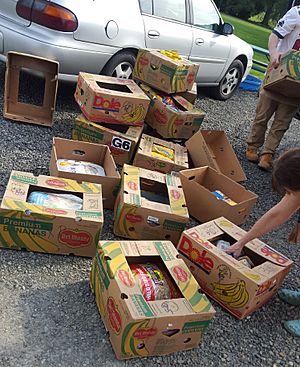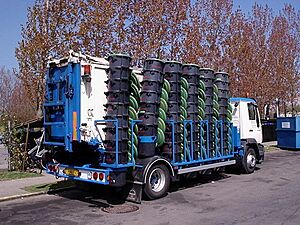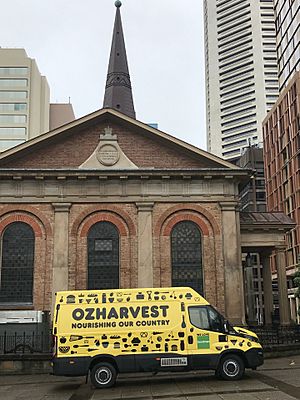Food rescue facts for kids
Food rescue is all about saving good, edible food that would otherwise be thrown away. This food comes from places like farms, grocery stores, restaurants, and even school cafeterias. Instead of going to waste, it's given to people who need it through local food programs.
Sometimes, the food is perfectly fine but might not look "perfect." For example, fruits and vegetables might be a funny shape or color. Other times, food might be close to its "sell by" date, or a grocery store might have too much. Restaurants might have extra food they cooked, or good pieces of food left over from preparing meals. Even food factories might donate products that are slightly off or have a short "best before" date. What these dates mean can be different in various countries.
Organizations that save food often work with food banks, food pantries, soup kitchens, and shelters. They make sure the food stays safe while being stored and moved. They also share information quickly so that food that spoils fast can get to people who can use it right away. There are even apps now that help connect extra food with people and charities!
Saving food helps people who don't have enough to eat. It also helps our planet by reducing greenhouse gas emissions. When food rots in landfills, it creates harmful gases. Food rescue is a big step in helping cities become carbon neutral. Countries like France have even made laws requiring supermarkets to donate unsold food instead of throwing it out. In October 2021, the city of Milan, Italy, won an Earthshot Prize for its amazing work in redistributing extra food.
Contents
How Food Rescue Works
Most rescued food is saved from being thrown into a dumpster and ending up in landfills. Food saved from farms might have been left in the fields. Volunteers often help harvest, or "glean," this food. The USDA also helps farmers get loans for more storage. This way, farmers can protect more food from going to waste.
In the United States, businesses that donate food for rescue programs get tax benefits. They are also protected from lawsuits by a law called the Emerson Good Samaritan Food Donation Act, which started in 1996.
A great benefit of food rescue is that it provides healthy food to people in need. This includes people living in a "food desert," which is an area where it's hard to find healthy and affordable food. Food rescue programs can also help people who don't qualify for other government food programs. Many programs offer immediate help without a long application process. Since so much edible food is thrown away and free to take, food rescue groups can be very flexible. This means they can often provide food faster and more easily than other hunger relief programs.
Food Waste and Climate Change
The UN's Food and Agriculture Organization says that food waste is the third-largest source of greenhouse gas emissions. About 98% of wasted food ends up in landfills. There, it breaks down and releases methane gas into the air. Methane is a very powerful gas, over 20 times stronger than carbon dioxide at warming our planet.
Wasted food in landfills causes 8-10% of all global greenhouse gas emissions. These gases from rotting food make global temperatures warmer and lead to extreme weather. They also contribute to sea level rise and other environmental problems.
Food rescue helps fight these greenhouse gas emissions. For every US dollar spent on saving food from landfills, about 7.5 kilograms of greenhouse gas emissions are avoided.
For example, between August 2016 and July 2017, a big resort in Las Vegas, Nevada, worked with a food bank. They saved over 24,000 kilograms of extra food from large events. This program provided over 45,000 meals to people who needed them. It also stopped about 108 metric tons of greenhouse gases from going into the air. That's like saving the amount of gas from burning 250 barrels of oil!
Ways to Rescue Food
There are many ways to save food from going to a landfill. The United States Environmental Protection Agency (EPA) suggests these actions, from best to least desirable:
Reducing Food Waste
This means making less food waste in the first place. At home, you can make shopping lists so you don't buy too much food. You can also buy smaller amounts of fresh food more often to avoid it spoiling. Many people waste food because they don't understand food labels like "best before" dates. Learning about these labels can help. A good tip is to use bright tape to mark foods that need to be used soon.
Reducing waste is important at every step of the food supply chain. This can include donating food, or turning food scraps into new food products. It also means saving ""ugly" vegetables" from farms that might otherwise be thrown away. By reducing waste, we can make sure more food is available for people to eat. This helps us become more self-sufficient and benefits the environment, economy, and society.
Apps like Flashfood in Canada and the United States help reduce waste. They tell users about big discounts on groceries that are about to expire. People can buy these items online and pick them up at the store. The Too Good to Go app, started in Denmark in 2015, lets customers buy discounted "Surprise Bags" of food from restaurants and bakeries. By 2022, it was used in 15 countries.
Feeding People
Organizations can donate both non-perishable (like canned goods) and unspoiled perishable food (like fresh produce) to food banks, food pantries, homeless shelters, and other groups that give food to people.
Some individuals who save food are called freegans or dumpster divers.
Feeding Animals
Many animals can eat food scraps. But just like with humans, spoiled food can make animals sick. Farmers and recycling centers sometimes collect discarded food for animals. Rules for this can vary by local laws.
Industrial Uses
Anaerobic digestion is a process that turns food waste into renewable energy. Food is separated from its packaging, then broken down and mixed with bacteria in special tanks without oxygen. The bacteria turn the waste into biogas (like methane), which can be used to make electricity.
Another process, Hydrothermal liquefaction, heats food waste under high pressure. This turns the waste into an oil that can be made into fuel. The leftover watery waste then goes through anaerobic digestion to create more biogas.
Fats, oils, grease, and meat products can also be used for rendering (turning animal parts into useful products) and making biodiesel.
Composting
Adding leftover food waste to a compost pile is a great idea. Composting has many benefits over sending waste to landfills. It reduces methane gas and improves the quality of the soil.
Food Rescue Around the World
Many groups and governments worldwide are working to save food and reduce greenhouse gases. The 2015 Sustainable Development Goals (SDGs) aim to cut global food waste in half by 2030.
Australia
As of 2022, about one in six Australians faced food insecurity (meaning they didn't always have enough food). Australia was the first country to adopt the SDG goal of cutting food waste by 50%. The Australian government supports food rescue efforts.
Australia's main food rescue group is OzHarvest. It works with over 3,000 food donors and 1,800 charities. OzHarvest has provided over 210 million meals. You can find locations using their online tool.
OzHarvest was started in 2004 by Ronni Kahn. She saw how much food was wasted at events. Kahn also helped change Australia's laws in 2005. This made it easier for groups like OzHarvest to give away food without worrying about legal problems.
Canada
Food Banks Canada is a national charity for food banks across Canada. In 2017, one in eight families (12.5%) in Canada reported not having enough food. By June 2022, researchers found that one in five Canadians (20%) reported going hungry.
University students in Canada are especially at risk. A survey in October 2021 found that 56.8% of students at 13 Canadian universities experienced food insecurity. This was up from 41.7% in 2020. Indigenous, LGBTQ+, and international students were even more likely to need food.
Second Harvest Toronto started in Toronto, Canada, in 1985. They began by working with restaurants, then expanded to larger distribution centers. Second Harvest partners with big companies like Loblaw's, Canada's largest food retailer. Loblaw's has donated over 1.5 million pounds of extra food.
Second Harvest also has "Harvest Kitchens" that use donated food to make meals. These meals are given to seniors, homeless people, children, and others. Some Harvest Kitchens even train volunteers in cooking skills to help them find jobs. Their "Feeding Our Future" program provides food to children at summer camps. In 2022, they received requests for food for 6,000 children, much more than the 2,000 children the summer before. The Second Harvest Food Rescue App connects businesses with extra food directly to local charities.
Leftovers started in Calgary, Alberta, in 2012. It has grown to other cities like Edmonton and Winnipeg, Manitoba. Groups like LeftOvers provide healthier food, which can improve people's health.
In Squamish, British Columbia, the Squamish Helping Hands Society helps people experiencing homelessness. Their "Under One Roof" center has housing and food programs. It works with local groups to get donated food. The center's kitchen provides food to the community for free or at a price people can afford. The goal is for the food hub to create zero waste.
China
China's first food bank, the Green Food Bank in Shanghai, opened in 2014. It collects food that would be wasted and gives it to those in need. A new online marketplace sells items for less than a US cent. People can shop privately, but they need to show government ID to prove they are in need (low income, disabled, etc.).
France
The French government has made laws to reduce food waste. Since 2012, large companies that produce a lot of organic waste must recycle it. In 2016, France made it a law that supermarkets must donate their unsold food instead of throwing it away.
Guatemala
About 8% of people in Latin America are Indigenous peoples. They are almost three times more likely to live in extreme poverty. In Guatemala, the food bank Desarrollo en Movimiento (DEM) works with communities across the country, including Indigenous groups. The food bank makes sure its services fit the culture of different regions. This means providing local herbs and vegetables, avoiding foods with lactose (as many Indigenous people are lactose intolerant), and working with community leaders.
India
No Food Waste started in 2014 in Coimbatore, Tamil Nadu. This group has a network that saves extra food from weddings, parties, and other events. In their "Community Kitchens," No Food Waste makes and sells cheap hot meals for daily workers and others. Women from shelters help staff these kitchens and learn job skills. No Food Waste serves over 5,000 people daily in 15 cities.
Israel
Leket Israel is Israel's National Food Bank. It was started in 2003 by Joseph Gitler, who saw a lot of waste after weddings. Leket Israel gives out farm produce and cooked meals to people who need them.
One of their programs, the Soup Program, delivers meals to people who can't leave their homes. Leket also holds nutrition workshops in different languages, with help from health experts.
New Zealand
New Zealand's first food rescue group, Kaibosh, was founded in Wellington in 2008. It started by picking up food from a local store once a week. Kaibosh now has warehouses, drivers, and helped change laws in 2014 to allow businesses to donate food without legal risk. As of 2022, Kaibosh operates three branches, giving away 60 tonnes of extra food each month to over 130 charities. Their goal is "Zero food poverty. Zero food waste."
KiwiHarvest (originally FoodShare Dunedin) was started in Dunedin in 2012. It's part of the Aotearoa Food Rescue Alliance and gets some support from the government. A national campaign, "Love Food, Hate Waste," helped spread FoodShare's idea to other cities.
Fair Food, Auckland's first food rescue group, was founded in 2011. Other groups work in cities like Hamilton and Christchurch.
In Australia, food rescue efforts are part of a bigger "Fair Food" movement. This movement talks about food security, poverty, fair prices for farmers, home gardening, and buying local food.
Norway
A 2015 study found 53 charities running food rescue programs in Norway. Most donations came from supermarkets (59%), followed by bakeries.
As of 2017, 98% of Norwegian supermarkets sold discounted food that was close to its expiration date. However, only 48% donated extra food to charity. Two supermarket chains, KIWI and REMA 1000, were very active in donating food.
Most of the rescued food was given out by charities, often religious groups. Volunteers did most of the work, giving away prepared meals or bags of groceries. Giving out free food often helped charities connect with people who needed more help.
In June 2017, the Norwegian government and food industry signed an agreement to cut food waste in half by 2030. This goal applies to all parts of the food chain, from farms to consumers. They are working to teach consumers about "use by" and "best before" dates. They also transfer extra food to charities and have opened grocery stores that sell discounted food near its "best before" date.
Singapore
In Singapore, the Foodbank Singapore runs its own food rescue project. They collect extra food from different places around the island. In 2019, they started "Food Pantry 2.0," which uses vending machines to give out food 24 hours a day. People with a special food credit card can access these machines.
South Africa
In South Africa, about one-third of the country's food production is wasted each year. That's over 10 million tonnes of food! About 30 million people in South Africa don't have enough food. FoodForward SA provides 950,000 meals daily to people in disadvantaged communities. They connect with farmers, factories, and stores to get food.
FoodForward SA started in 2009. By 2019, they created "Mobile Rural Depots" (MRD) to reach rural communities better. Each depot gets monthly food deliveries. Local partner groups then collect and give out the food. In 2020, the MRD program worked with 108 groups to feed over 50,000 people in remote areas.
South Korea
Starting in Seoul, South Korea, in 2013, households had to pay a fee for recycling based on how much food waste they threw away. The amount of waste in Seoul dropped by 10% in four years. The program then expanded to 16 more Korean cities.
United Kingdom
In the United Kingdom, about 13.1 million tonnes of food waste are created each year. The average household throws away enough food for eight meals every week. Groups like Fareshare and Waste and Resources Action Programme (WRAP) work with food manufacturers to reduce waste.
WRAP reported that over 106,000 tonnes of extra food were given out in 2021. This equals 253 million meals and is worth over £330 million. About 69% of this extra food was given out through charities.
United States
The EPA estimated that in 2015, the USA produced over 39 million tons of food waste. The U.S. Department of Agriculture (USDA) and the U.S. Environmental Protection Agency (EPA) supported the 2015 Sustainable Development Goals to cut food waste by 50%. In 2018, supermarkets threw away 20–40% of produce just because it didn't look perfect, even though it was good to eat.
Many food rescue groups and volunteers across the United States pick up and deliver food. They use refrigerated trucks when needed. The food goes to people with low or no income.
Sustainable America has an online directory called The Food Rescue Locator. The U.S. Department of Agriculture (USDA) also has a Hunger Hotline at 1-866-348-6479.
John van Hengel founded the world's first food bank, St. Mary's Food Bank, in Phoenix, Arizona, in 1967. He also created a national network for food banks called Second Harvest in 1979. In 2008, Second Harvest changed its name to Feeding America. This group now includes over 200 regional food banks.
Other well-known food rescue groups include The Farmlink Project (in over 48 states), Food Rescue US (in over 20 states and Washington, DC), La Soupe (in Cincinnati, Ohio), City Harvest (in New York City), and Philabundance and Sharing Excess (in Philadelphia, Pennsylvania). The Society of St. Andrew is a volunteer group that "gleans" food from farms.
Feeding America estimates that food insecurity increased by 50% during the COVID-19 pandemic. One in five Americans sought help from food banks during this time. City Harvest reported that food pantries in New York City served about 3.5 million visitors each month in 2022. This was a 69% increase from 2019.
Groups like Waste No Food, Food Rescue US, and Sharing Excess use apps to tell charities where and when extra food is available. 412 Food Rescue, started in Pittsburgh in 2015, is even testing using autonomous cars to pick up and deliver food. This could help with the shortage of drivers.
See also
- Feeding America
- Freeganism
- Food loss and waste
- Garbage picking
- Love Food, Hate Waste
- Pending meal
- United States Department of Agriculture
- Upcycling





